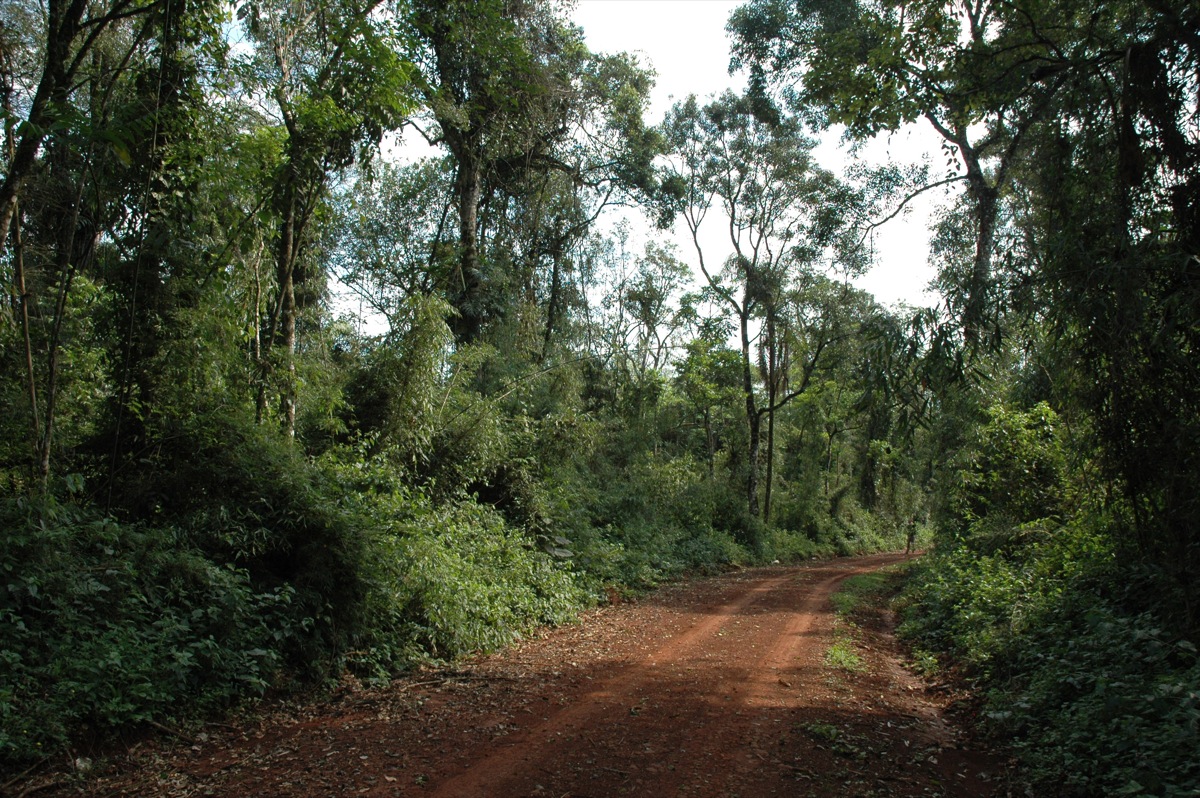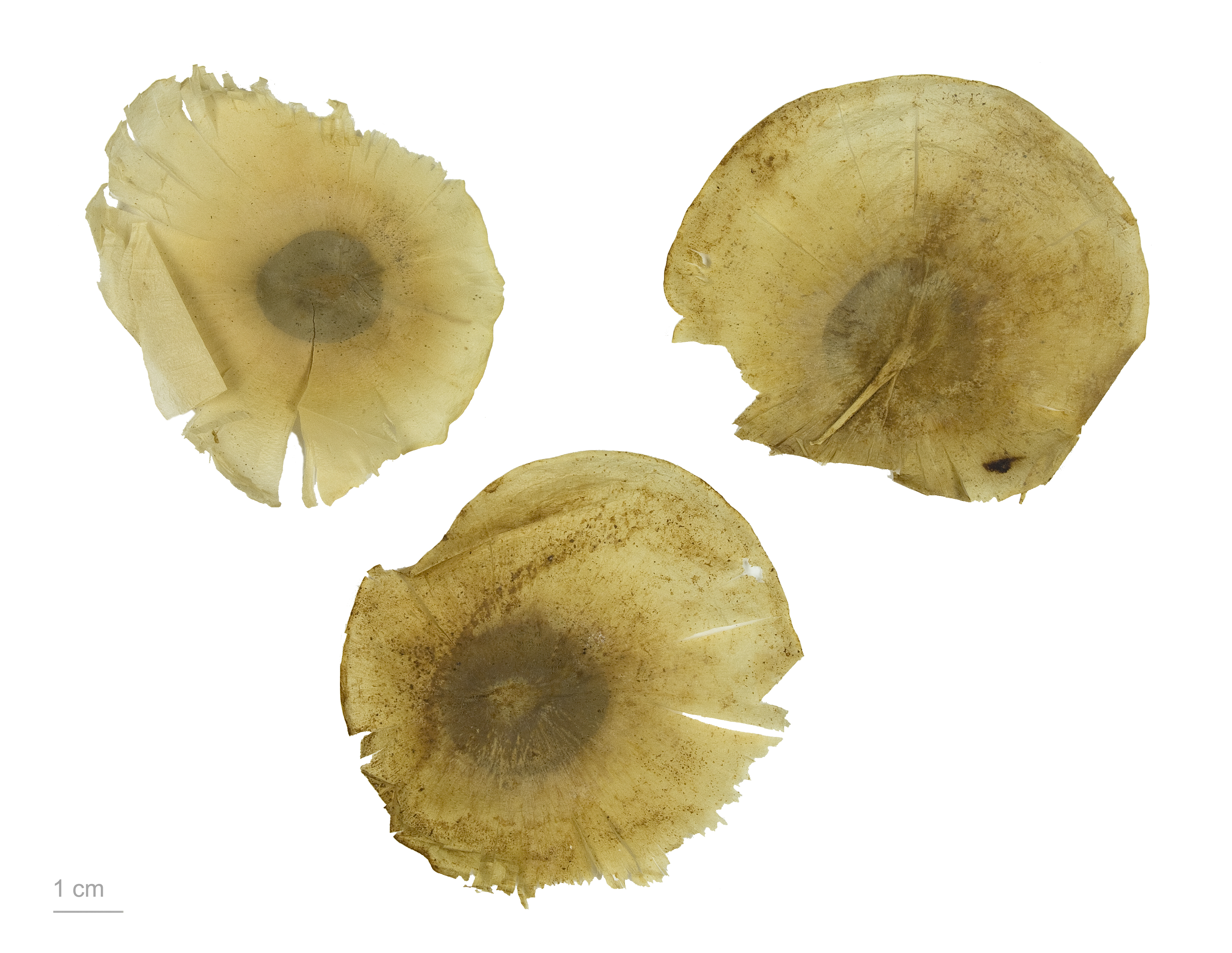|
Turvo State Park
The Turvo State Park ( pt, Parque Estadual do Turvo) is a state park in the state of Rio Grande do Sul, Brazil. It protects the last large area of well-preserved Upper Uruguay forest in the state, which is home to several rare or endangered species. The park is best known for the dramatic Yucumã Falls on the Uruguay River, the second-widest in the world by some measures. The falls may be threatened by flooding from the planned Garabí-Panambi Hydroelectric Complex if a 2015 court ruling is overturned. Location The Turvo State Park is in the Northwest of Rio Grande do Sul, covering almost half of the municipality of Derrubadas. It has an area of . To the north Argentina and Santa Catarina are the other side of the Uruguay River. The park is bounded to the west by the Turvo River and to the east by the Parizinho River. There are rural properties to the south. The park includes the Yucumã Falls ( pt, Salto do Yucumã, es, Saltos del Moconá), a dramatic linear waterfall on ... [...More Info...] [...Related Items...] OR: [Wikipedia] [Google] [Baidu] |
Rio Turvo State Park
The Rio Turvo State Park ( pt, Parque Estadual Rio Turvo) is a state park in the state of São Paulo, Brazil. It protects an area of Atlantic Forest. A man's skeleton from 9,000 years ago was found in the park area in 1999. Location The Rio Turvo State Park is in the municipalities of Barra do Turvo (69.93%), Cajati (16.45%) and Jacupiranga (13.62%) of São Paulo. It has an area of . Several communities of traditional populations live in the area around the park. History The Rio Turvo State Park was one of several conservation units created by state law 12.810 of 21 February 2008, in which the Jacupiranga Mosaic was created from the former Jacupiranga State Park and its surrounding lands. By 2012 about 11,000 people were visiting the park each year. On 28 November 2012 the park officially opened a Thematic Exhibition Center at the Capelinha Center. The building cost about RS$639,800, using funds provided in compensation for construction of a toll road in the area. Environme ... [...More Info...] [...Related Items...] OR: [Wikipedia] [Google] [Baidu] |
Sorocea Bonplandii
''Sorocea'' is a Neotropical genus of woody plants in the family Moraceae. Its distribution ranges from Chiapas to southern Brazil. It is placed within the tribe Moreae, and is closely related to the monotypic ''Bagassa''. Species List According to Kew, there are currently 22 accepted species: * '' Sorocea affinis'' Hemsl. * '' Sorocea angustifolia'' Al.Santos & Romaniuc * '' Sorocea bonplandii'' (Baill.) W.C.Burger, Lanj. & de Boer * '' Sorocea briquetii'' J.F.Macbr. * '' Sorocea carautana'' M.D.M.Vianna, Carrijo & Romaniuc * '' Sorocea duckei'' W.C.Burger * '' Sorocea ganevii'' R.M.Castro * '' Sorocea guilleminiana'' Gaudich. * '' Sorocea hilarii'' Gaudich. * '' Sorocea jaramilloi'' C.C.Berg * '' Sorocea jureiana'' Romaniuc * '' Sorocea klotzschiana'' Baill. * '' Sorocea longipedicellata'' A.F.P.Machado, M.D.M.Vianna & Romaniuc * '' Sorocea muriculata'' Miq. * '' Sorocea pubivena'' Hemsl. * '' Sorocea racemosa'' Gaudich. * '' Sorocea ruminata'' C.C.Berg * '' Soroce ... [...More Info...] [...Related Items...] OR: [Wikipedia] [Google] [Baidu] |
Southern Tamandua
The southern tamandua (''Tamandua tetradactyla''), also called the collared anteater or lesser anteater, is a species of anteater from South America and the island of Trinidad in the Caribbean. It is a solitary animal found in many habitats, from mature to highly disturbed secondary forests and arid savannas. It feeds on ants, termites, and bees. Its very strong foreclaws can be used to break insect nests or to defend itself. Distribution and habitat The southern tamandua is found in Trinidad and throughout South America from Venezuela to northern Argentina, southern Brazil, and Uruguay at elevations up to . It inhabits both wet and dry forests, including tropical rainforest, savanna, and thorn scrub. It seems to be most common in habitats near streams and rivers, especially those thick with vines and epiphytes (presumably because its prey is common in these areas). The oldest fossil tamanduas date from the Pleistocene of South America, although genetic evidence suggests th ... [...More Info...] [...Related Items...] OR: [Wikipedia] [Google] [Baidu] |
Ocelot
The ocelot (''Leopardus pardalis'') is a medium-sized spotted wild cat that reaches at the shoulders and weighs between on average. It was first described by Carl Linnaeus in 1758. Two subspecies are recognized. It is native to the southwestern United States, Mexico, Central and South America, and to the Caribbean islands of Trinidad and Margarita. It prefers areas close to water sources with dense vegetation cover and high prey availability. Typically active during twilight and at night, the ocelot tends to be solitary and territorial. It is efficient at climbing, leaping and swimming. It preys on small terrestrial mammals, such as armadillos, opossums, and lagomorphs. Both sexes become sexually mature at around two years of age and can breed throughout the year; peak mating season varies geographically. After a gestation period of two to three months the female gives birth to a litter of one to three kittens. They stay with their mother for up to two years, after whi ... [...More Info...] [...Related Items...] OR: [Wikipedia] [Google] [Baidu] |
Deer
Deer or true deer are hoofed ruminant mammals forming the family Cervidae. The two main groups of deer are the Cervinae, including the muntjac, the elk (wapiti), the red deer, and the fallow deer; and the Capreolinae, including the reindeer (caribou), white-tailed deer, the roe deer, and the moose. Male deer of all species (except the water deer), as well as female reindeer, grow and shed new antlers each year. In this they differ from permanently horned antelope, which are part of a different family ( Bovidae) within the same order of even-toed ungulates (Artiodactyla). The musk deer ( Moschidae) of Asia and chevrotains ( Tragulidae) of tropical African and Asian forests are separate families that are also in the ruminant clade Ruminantia; they are not especially closely related to Cervidae. Deer appear in art from Paleolithic cave paintings onwards, and they have played a role in mythology, religion, and literature throughout history, as well as in hera ... [...More Info...] [...Related Items...] OR: [Wikipedia] [Google] [Baidu] |
South American Tapir
The South American tapir (''Tapirus terrestris''), also commonly called the Brazilian tapir (from the Tupi ''tapi'ira''), the Amazonian tapir, the maned tapir, the lowland tapir, the ''anta'' ( Portuguese), and ''la sachavaca'' (literally "bushcow", in mixed Quechua and Spanish), is one of the four recognized species in the tapir family (of the order '' Perissodactyla'', with the mountain tapir, the Malayan tapir, and the Baird's tapir). It is the largest surviving native terrestrial mammal in the Amazon. Most classification taxons also include ''Tapirus kabomani'' (also known as the little black tapir or kabomani tapir) as also belonging to the species ''Tapirus terrestris'' (Brazilian tapir), despite its questionable existence and the overall lack of information on its habits and distribution. The specific epithet derives from ''arabo kabomani'', the word for tapir in the local Paumarí language. The formal description of this tapir did not suggest a common name for the ... [...More Info...] [...Related Items...] OR: [Wikipedia] [Google] [Baidu] |
Collared Peccary
The collared peccary (''Dicotyles tajacu'') is a species of artiodactyl (even-toed) mammal in the family Tayassuidae found in North, Central, and South America. It is the only member of the genus ''Dicotyles''. They are commonly referred to as ''javelina, saíno'', or ''báquiro'', although these terms are also used to describe other species in the family. The species is also known as the musk hog. In Trinidad, it is colloquially known as ''quenk''. Taxonomy Although somewhat related to true Old World pigs, and frequently referred to as a pig, this species and the other peccaries are no longer classified in the pig family, Suidae. Although formerly classified in the genus ''Pecari'', studies in 2020 placed them in the genus ''Dicotyles'', based on an unequivocal type-species selection; these studies have been accepted by the American Society of Mammalogists. Currently, the IUCN still places them in the genus ''Pecari''. Description The collared peccary stands around tall ... [...More Info...] [...Related Items...] OR: [Wikipedia] [Google] [Baidu] |
Cougar
The cougar (''Puma concolor'') is a large cat native to the Americas. Its range spans from the Canadian Yukon to the southern Andes in South America and is the most widespread of any large wild terrestrial mammal in the Western Hemisphere. It is an adaptable, generalist species, occurring in most American habitat types. This wide range has brought it many common names, including puma, mountain lion, catamount and panther (for the Florida sub-population). It is the second-largest cat in the New World, after the jaguar (''Panthera onca''). Secretive and largely solitary by nature, the cougar is properly considered both nocturnal and crepuscular, although daytime sightings do occur. Despite its size, the cougar is more closely related to smaller felines, including the domestic cat (''Felis catus'') than to any species of the subfamily Pantherinae. The cougar is an ambush predator that pursues a wide variety of prey. Primary food sources are ungulates, particularly deer, but it a ... [...More Info...] [...Related Items...] OR: [Wikipedia] [Google] [Baidu] |
Cassia Fistula
''Cassia fistula'', commonly known as golden shower, purging cassia, Indian laburnum, or pudding-pipe tree,U. S. Department of Agriculture, William Saunders; Catalogue of Economic Plants in the Collection of the U. S. Department of Agriculture; Washington D. C.; June 5, 1891 is a flowering plant in the family Fabaceae. The species is native to the Indian subcontinent and adjacent regions of Southeast Asia, from southern Pakistan through India and Sri Lanka to Bangladesh, Myanmar and Thailand. It is a popular ornamental plant and is also used in herbal medicine. Description The golden shower tree is a medium-sized tree, growing to tall with fast growth. The leaves are deciduous, long, and pinnate with three to eight pairs of leaflets, each leaflet long and broad. The flowers are produced in pendulous racemes long, each flower diameter with five yellow petals of equal size and shape. The fruit is a legume, long and broad, with a pungent odor and containing several seeds. ... [...More Info...] [...Related Items...] OR: [Wikipedia] [Google] [Baidu] |
Aspidosperma Parviflorum
''Aspidosperma'' is a genus of flowering plant in the family Apocynaceae, first described as a genus in 1824. It is native to South America, Central America, southern Mexico, and the West Indies The West Indies is a subregion of North America, surrounded by the North Atlantic Ocean and the Caribbean Sea that includes 13 independent island countries and 18 dependencies and other territories in three major archipelagos: the Greater A .... ;Species References Apocynaceae genera {{Apocynaceae-stub ...[...More Info...] [...Related Items...] OR: [Wikipedia] [Google] [Baidu] |


.jpg)




